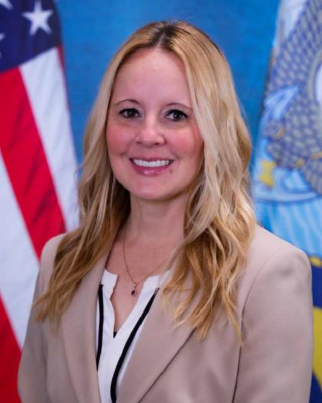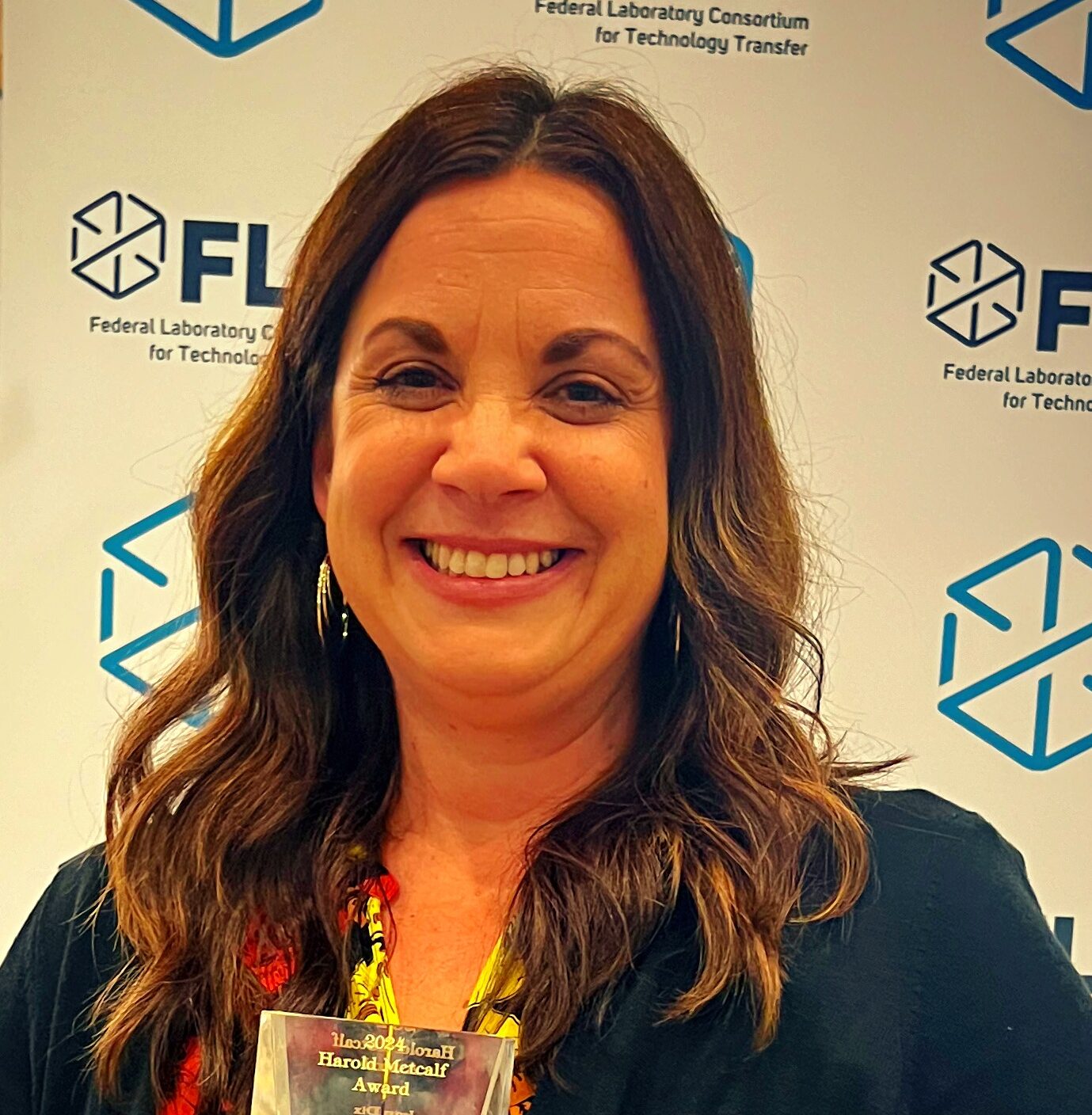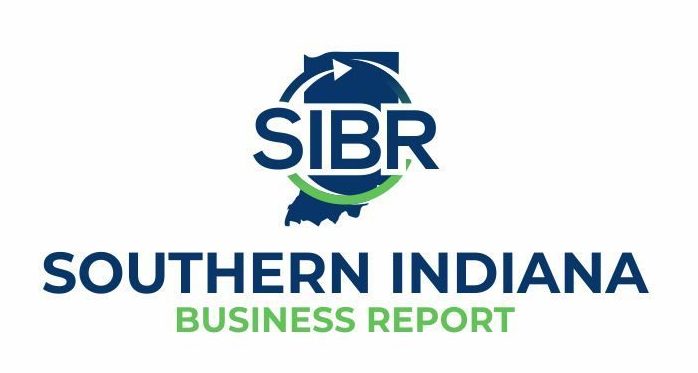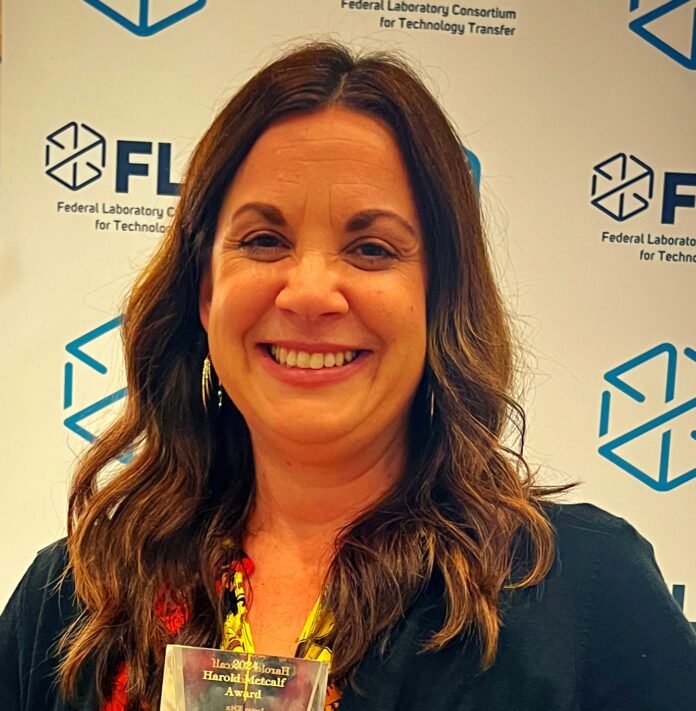Sarah K. Oh, NSWC Crane Corporate Communications
CRANE – Naval Surface Warfare Center, Crane Division (NSWC Crane) was recognized with two awards by the Federal Laboratory Consortium (FLC) for technology transfer (T2) contributions during an FLC national meeting in Dallas, Texas April 10.
Jenna Dix, director of engagement for NSWC Crane, was awarded the Harold Metcalf Award for FLC Service, which celebrates a federal laboratory employee who has provided significant and noteworthy service to FLC throughout their career. NSWC Crane T2 team was awarded the Best in Region, which recognizes T2 excellence across federal laboratories in the Midwest region. FLC is a network of more than 300 U.S. federal laboratories aimed at fostering the acceleration of federal technologies to industry.
“Serving on the FLC has really been a highlight of my career,” said Dix. “The organization is committed to its mission of making the most out of the research and development (R&D) happening in the federal lab system, and the professionals that work in this space are truly remarkable. From a Crane standpoint, we have long been looked to as national leaders in tech transfer and this is further evidence of that. Since 2009, Crane has won 25 awards from the FLC for excellence in Tech Transfer, along with a handful of Department of Defense (DOD) awards. The receipt of the Metcalf and a Best in Region show Crane’s enduring leadership that exists – enduring as among the best in federal labs at T2.”
Maria Duran, the T2 director at NSWC Crane, said receiving Best in Region expresses the continued success of NSWC Crane’s Technology Transfer Program.

“The awards NSWC Crane has won over the past 15 years show our excellence in T2,” said Duran. “The Best in Region award recognizes a continuation of what was done in the past and NSWC Crane’s T2 legacy. It shows how the leadership at NSWC Crane leveraged internal capability and external partnerships in the ecosystem. It wouldn’t happen if the workforce wasn’t engaged. We are going to keep growing.”
Duran adds the FLC Best in Region award recognized NSWC Crane’s efforts growing the PROPELS Accelerator program which is a several week-long program for entrepreneurs to commercialized government technology. The PROPELS Accelerator was a collaboration with many regional partners, including Radius Indiana, Elevate Ventures, Applied Research Institute, The Dimension Mill, and the Indiana Small Business Development Center.
“This effort established an accelerator program that connected laboratory scientists and engineers directly with entrepreneurs and small businesses and guided them through a six-week accelerator program to provide them with the tools and resources for commercializing federal technologies,” said Duran. “The initiative originally designed to spur economic recovery in the wake of the COVID-19 pandemic was expanded in 2023 to include additional locations and collaboration with the Central Florida Technology Grove in Orlando, FL and Naval Air Warfare Center Training Systems Division, resulting in additional federal lab partnership and access to additional resources as well as a broader network.”
Dix started her career at NSWC Crane in 2005 and later transitioned to the Chief Technology Office supporting T2 in 2015 and worked there until 2022. She served as the director of the Technology Transfer Program and as the Office of Naval Research designee as NSWC Crane’s Office of Research and Technology Applications (ORTA). There, she was responsible for the strategic management of NSWC Crane’s intellectual capital and for developing key strategic partnerships to enhance the research and development capabilities of NSWC Crane. She also spent four years connecting NSWC Crane’s science and technology community with external resources to achieve research and development goals and expedite delivery of capability to the warfighter.
Dix served as the FLC Deputy Regional Coordinator of the Midwest Region, expanding across 30 federal labs and six states. Dix also served as FLC Regional Coordinator, on an FLC planning committee for strategic growth, Inaugural Chair of the FLC Facilitate Committee, and member of the Executive Board. As stated in Dix’s Metcalf Award nomination, FLC facilitate has increased FLC engagement and added 17 new strategic partnerships, an increase of more than 1,000 participants in FLC events. Dix has received nine awards from FLC while supporting T2.
In 2023, she become Director of Engagement where she is responsible for advocacy and engagement for NSWC Crane. The Office of Engagement is responsible for fostering outreach to the Innovation Ecosystem, accelerating the development of technology transition to the warfighter, and position NSWC Crane to meet the current and future needs of the DOD and Navy.
“We’re here to create partnerships for Crane that help ensure we’re able to meet our mission,” said Dix. “That is the simplest way to say it, but when you consider the impact of such partnerships, they’re vast. They not only provide opportunities for us to more rapidly meet warfighter needs, but these partnerships create opportunities for others at the same time.”
The Innovation Ecosystem are the partners, collaborators, and organizations that NSWC Crane can work with to accelerate the development and transition technical capability to the warfighter. The ecosystem includes over 250 different organizations across academia, industry, other government agencies, small businesses, and entrepreneurs. The Massachusetts Institute of Technology (MIT) conducted an academic study on NSWC Crane’s Innovation Ecosystem in 2018, and published the results the next year contributing to the validation of the ecosystem’s strength. The study was validated by the National Security Commission on Artificial Intelligence and identified by the White House as a best practice among federal laboratories.
Dix is the third Director of Engagement for NSWC Crane and said the work continues to strengthen the ecosystem, including the Indiana Uplands and WestGate@Crane Technology Park.
“We’re continually working to expand our Innovation Ecosystem and provide new opportunities to partner to ensure we’re best situated to meet the needs of the Navy and the nation,” said Dix. “We are continuing to find opportunities where technical equities and priorities of various partners align with technical expertise at NSWC Crane. This provides a formidable advantage for collective success and we’ve seen that happen already with respect to microelectronics for example. We continue to look for opportunities that provide for the sum of the whole being greater than the sum of the parts.”
Microelectronics is an example of a technology area with strategic Innovation Ecosystem partnerships. NSWC Crane has many microelectronics subject matter experts and the DOD announced one of its eight “innovation hubs” in the Microelectronic Commons in Indiana.
Dix said these efforts tie directly to the mission.
“Strategic partnerships expedite our ability to develop technology and deliver it to the warfighter. Crane has immense relevance in the National Defense Strategy and all strategies that flow down from that, so it truly is a direct tie,” said Dix. “This is part of the uniqueness of Crane…the Navy comes to NSWC Crane, an organization of 3800 civilian employees, for a solution to a hard technical challenge. That customer doesn’t just get to leverage the 3800-strong of Crane. It gets to rely on our entire ecosystem to find its solution. It really is a force multiplier.”




